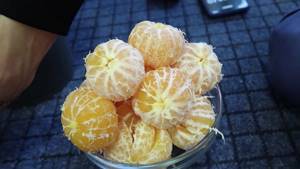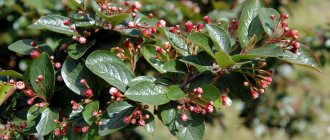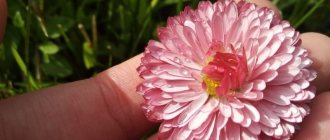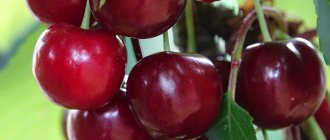Citrus
Author of the article: Anna Vladimirovna | Updated: 12/18/2020
Today, under the name “mandarin”, a huge number of different hybrids and varieties of citrus fruits are united, the common feature of which is a soft peel that is easily separated from the pulp. But, despite the existing abundance, the world selection is constantly being replenished with new hybrid forms of mandarin, so there is still no generally accepted classification of this crop. In order to somehow streamline the resulting chaos, V.P. Alekseev (1955) proposed dividing all varieties of tangerines into 7 main pomological groups, in accordance with their varietal characteristics.
Citrus unshiu
Inshiu or Satsuma tangerines are the oldest and most extensive group, obtained as a result of centuries of hard work by Japanese breeders. Its name comes from the variety of the same name, which was one of the first to be bred. A distinctive feature of these varieties is increased winter hardiness and the ability to fully ripen fruits with short daylight hours, which allows them to be actively grown in Russia and most European countries at home and in greenhouses. Under natural conditions, tangerine trees feel comfortable in the mild tropical climate of the Black Sea coast (Crimea, Caucasus).
The Unshiu mandarin is a very compact low tree, growing up to 2–3 m in the garden, and no more than 1.5 m at home. The external distinctive feature of the varieties of this group are large leathery leaves on thin, very flexible and slightly drooping stems. The crown is spreading, well branched, and thanks to the massive foliage it seems dense. The fruits are small (50–70 g), elongated, covered with a thin skin of light orange color, sometimes with rare green patches. Tangerines taste quite sweet and contain virtually no seeds, so they are considered seedless.
All varieties of this group are early ripening - the tree begins to actively bear fruit at the age of three, and can produce its first fruits at the age of 2 years. In nature, mandarin blossoms in May and is harvested in October, but at home it blooms almost all year round, ensuring continuous fruiting. A blooming tangerine looks especially magnificent - at this time the tree is covered with numerous inflorescences consisting of 4-6 white flowers.

The large Unshiu group includes the following well-known varieties of tangerines:
Pioneer-80. A domestic variety bred in the 50s of the last century at the Sochi Experimental Station. It is characterized by high cold resistance and is grown mainly in the Krasnodar region. The tree is low (up to 4.5 m), the crown is pyramidal, spreading. The fruits are flat-round, weighing 60–80 g, sweet and sour, the pulp is very juicy and tender, easily separated from the peel.
Sochinsky-23. A high-yielding early variety growing in Georgia and the southern part of the Russian Federation (Krasnodar Territory). The fruits are large (about 80 g), very aromatic, with juicy sweet pulp.
Abkhazian early ripening. Very sweet seedless tangerines, also of domestic selection. They grow mainly in the Caucasus. The trees are compact and low-growing. The fruits are bright orange, juicy, contain a lot of sugars, and are ready for harvesting in early October.
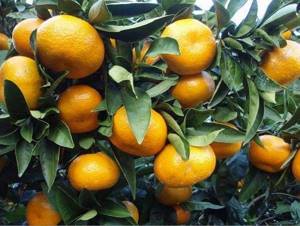
Kartuli Saadreo. This dwarf tangerine tree with a beautiful vertical crown is ideal for home growing. Fruiting is early and abundant. Despite its modest dimensions, such an indoor tangerine can bear several dozen fruits, which, moreover, are very sweet and aromatic.
Tangerines and hybrids \ Citrus reticulata \ Citrus deliciosa \ Citrus unshiu
Mandarin "Satsuma" variegated
C. unshiu "Foliis variegatis"
A rare, variegated variety of mandarin. The fruits are medium and large (for tangerines) in size, juicy, with a good balance of sugar and acids. At the beginning of ripening they have a striped color; when fully ripe, they acquire the characteristic orange color of the variety. There are no seeds. The peel is bright orange, easily separated from the pulp, thin.
Mandarin "Miagawa"
C. unshiu "Miagawa" \ satsuma "Miagawa"
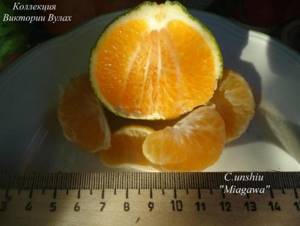
The variety is very productive, currently very widespread and famous. The fruits are large, seedless, with a thin and smooth skin. Juicy, with a good balance of sugar and acids, sweet, of excellent quality. Early ripening variety.
Mandarin "Miagawa" nucellar 00
C. unshiu "Miagawa nucellare"\"Miagawa 00"
A precocious mutation of the unshiu "Miyagawa" mandarin, it comes from Japan. It ripens 14 days earlier than the usual “Miagawa” - already in the first half of September. A small tree or bush. The fruits are spherical, sometimes flattened, large, about 130g, with a thin, deep orange, easily separated peel. The pulp has excellent taste, low acid content, sweet and very juicy. It consists of 8 -10 segments, without seeds. The fruits can hang on the tree for a long time without deteriorating in taste.
Mandarin "Abkhazian early ripening"
C.unshiu
Grown on the Black Sea coast of the Caucasus. The trees are low-growing, leaves are 7.0-8.5 cm long, 3-4.5 cm wide, oval or rhombic; petioles short, edged. The fruits are large, up to 5.5 cm in diameter, with a thin, bright orange, easily peelable peel and juicy sweet and sour pulp. Fruit ripening begins in mid-October.
Mandarin "Iwasaki"
C. unshiu "Iwasaki" \ Satsuma mandarin
Belongs to the group of the earliest ripening tangerines in the world - Iwasaki. The ripening period is from the first ten days of September to the first ten days of October. It is a mutation of the Okitsu mandarin, which originated in Japan. Tree of vigorous growth, without thorns. A typical “weeping” growth form for the Unshiu group. The fruits are of excellent quality, with a harmonious taste.
Mandarin "Hashimoto"
C. unshiu "Hashimoto"
Originates in Japan and belongs to the very early ripening group of Unshiu mandarins - “Goko Wase”. It was discovered in 1963 by M. Hashimoto as the "Matsuyama" sport, in Tomange and Aichi. A dwarf tree or bush with thorns and elongated, dark green leaves. Requires a minimum volume of soil. It begins to bear fruit very early. The fruits are typical of Unshiu, slightly flattened, large (similar to the 'Okitsu' fruit). The peel is dark orange, quite thin, and easily removable. The pulp is juicy, sweet and aromatic. It is one of the few Unshiu varieties cultivated in Spain, where it ripens from early September. Therefore, from a commercial point of view, it is more interesting than, for example, 'Okitsu' (which has slightly more tasty fruits). The fruits quickly lose quality while remaining on the tree. The variety prefers rather poor sandy soils and feels great in pots.
Mandarin "Xi-Shan"
C. unshiu "Xie Shan" Satsuma mandarin
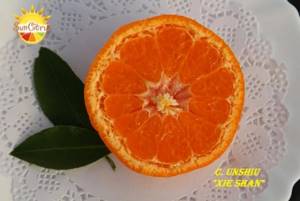
Xie Shan is the Chinese translation of the original Japanese title 'Wakayama'.
Early ripening variety from China. It has a unique taste and aroma that is different from other Satsumas. With harvest beginning in mid-September, 'Xie Shan' joins 'Miagawa' in a group of new, completely seedless, super-early Satsumas. Mandarin "Kishu Mikan" seedless
Seedless Kishu \ Citrus kinokuni mukakukishu
Mandarin "Mukakukishu" (Mukaku) is commonly called "Seedless Kishu" (Mini). Early variety. The variety originally developed naturally in the wild and exotic forest of Southern China, where the water and soil quality are excellent. Mandarin fruits are very small, sometimes with a small neck, slightly flattened. It is distinguished by excellent yield, sweet, with very low acidity and without seeds. The peel is thin and very easy to clean. The pulp is dense, fleshy and pleasantly sweet. It is considered a very old species of Chinese origin and one of the earliest. Introduced to Japan in 1954, where it remains popular for its pleasant taste and rich aroma. There are at least four known varieties, the largest of which is "Hirakishu" Mukakukishu - this completely seedless variety is also known as "Seedless Kishu". Seedless Kishu is a unique mutation. The pollen can be used experimentally to develop new varieties, with approximately 50% of the offspring expected to be seedless. The fruit of some Kishu Seedless hybrids may be too small for commercial applications, but it is hoped that others will incorporate its many positive characteristics while maintaining the fruit size of the parents.
Mandarin "Dekopon" \ "Dekopan" \ Citrus "Sumo"
Citrus "Sumo"\tangerine "Shiranui"\"Dekopon"
"Dekopon" is another name for the "Shiranui" mandarin, a Japanese hybrid of the "Kiyomi" tangor and the "Ponkan" mandarin, a triploid. In the USA it is also known as “Sumo”, in Korea “Hallabong”. Also grown in China and Brazil (here called "Kinsei"). It is considered one of the most delicious hybrid tangerines. For a long time it was banned from exporting from Japan. The plant is medium-sized, erect, the branches have thorns when young. The leaf is small, with a narrow lionfish. The fruits are large, the size of a grapefruit with a clearly defined neck. Their surface is rough and orange when fully ripe. The taste has the perfect balance of sugar and acid. Late ripening variety. Ripens in January-March. After shooting, it is recommended to keep the fruits in storage for about 14 more days to improve their taste.
Mandarin "Dekopon" variegated \ "Dekopan" \ Citrus "Sumo"
Mandarin "Mandared"
Mandarin "Mandared" \ Red flesh tangerine
Mandared is the first!!! tangerine with red pulp. This is a new triploid hybrid obtained by crossing a Nules Clementine (2x) x a Tarocco Orange (4x). A variety with a vigorous growth rate, with the habit of growing wider, with medium-sized spines. The leaves are elliptical in shape with a pointed tip, the petiole is of medium length, similar to the petiole of "Tarocco". The taste is intermediate between clementine and Tarocco orange. The fruits have absorbed the best characteristics of the parent plants. The shape is flattened, the average weight is about 170 g, the peel is fine-grained, dark orange in color. The pulp is pigmented, sweet, incredibly juicy. For the flesh to acquire an intense bloody hue, daily temperature fluctuations are necessary. Ripening later, harvesting begins in mid-February and lasts until April.
New varieties of mandarins from Riverside
Tahoe Gold™, Yosemite Gold™, Shasta Gold™
Mandarin "Yosemite Gold"
S. reticulata “Yosemite Gold ® TM” (TDE4) \ Yosemite Gold mandarin
Yosemite Gold TM (TDE4) – hybrid (tangor “Temple” x 4n “Dancy” mandarin) x “Encore” mandarin, triploid. A recently released (2002) tangerine cultivar developed by the Riverside University of California citrus breeding program. The tree grows intensively both vertically and in width, and has a tendency to alternate fruiting. The large fruits have an attractive, smooth, dark orange skin that is relatively thin. The flesh is seedless, bright orange, finely textured and juicy. The aroma is rich and sweet. The season for “Yosemite Gold” TM (TDE4) is January to mid-March, and the fruit stays well on the tree until April.
Mandarin "Tahoe Gold" \"Tahoe"
C. reticulata “Tahoe Gold” ® TM” (TDE3) \ Tahoe Gold mandarin
Tahoe Gold ® is a recently released (2002) tangerine cultivar developed by the University of California, Riverside citrus breeding program. The tree is vigorous and has a somewhat creeping habit, with a tendency to have variable yield. Tahoe Gold ® (TDE3) is a hybrid between Temple tangor and Dancy and Encore tangerines. Ripens mid-season. Combines large fruit size, attractive deep orange rind color, rich fruit flavor and virtual absence of seeds, even in mixed plantings. Season for Tahoe Gold ® is mid-January to mid-February in Riverside.
Mandarin "Sweet Sicily®"
C. deliciosa "Sweet Sicily®" \ Ibrido Sweet Sicily®
Hybrid of clementine “Comune 2x” x orange “Tarocco tetraploide”. The fruits are juicy (49%), without seeds, easy to peel, round or slightly flattened, smooth skin. Average weight 180-210g. The pulp is juicy and pleasant to the taste.
Mandarin "Pixie" \ "Pix Mandi" \ Tangerine
Citrus reticulata "Pixie" \ C. reticulata "Pix Mandi" \ Pixie tangerines \ Pixie mandarin
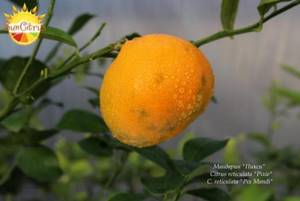
Pixie is the result of an open-pollinated Kincy (King X Dancy) that took place in 1927 and was released in 1965. The tree is vigorous, growing mostly upright. The fruits are usually spherical or slightly flattened and sometimes have a neck. The peel is yellow-orange and easy to peel. The pulp is seedless, orange, juicy. The taste is soft and sweet. The fruits ripen at the end of winter and can hang on the tree for a very long time.
Video from the network https://www.youtube.com/watch?v=IwOxifEPpE0
Mandarin “Kinnow”
C. reticulata “kinnow” \ Ibrid tangor “King” x mandarin “Willowleaf”
A hybrid variety, was bred at the University of California at Riverside (Howard B. Frost Research Center 1915 - 1925).
"King" x "Mediterranean". It is currently the number one commercial mandarin variety grown in Pakistan (up to 70% of all mandarins), and is also grown in India, California and Arizona. A tree with a vertical growth pattern, the branches are thin, long, drooping and practically without thorns. The leaves are medium-sized, leathery, shiny, shaped like the tip of a spear. The fruits are medium-sized (4.5-7cm), round, slightly flattened, and can weigh up to 70-100g. The peel is thin, very smooth, shiny, tightly fitting. The pulp is very juicy (up to 43%), aromatic and very sweet. The fruit consists of 12 segments with a large number of polyembryonic seeds. The ripening period is usually from December to February, and the fruits can remain on the tree for a long time without loss of quality. The fruits can be found on sale under the name “Honey”.
Mandarin "Nova" \ Clementine "Nova" \ Tangelo "Nova"
C. deliciosa "Nova" \ C. clementina "Nova" \ C. tangelo "Nova"
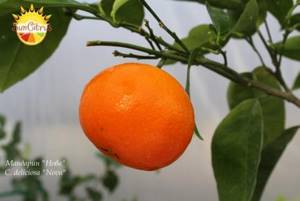
The Nova mandarin is related to the Lee, Osceola and Robinson mandarins.
In Europe it is called "Clemenvilla". Hybrid of clementine "Fina" and tangelo "Orlando". In 1971, it was introduced to Europe, where it was named "Clemenvilla". The tree grows quickly and may have thorns. Medium size fruits 110-140 gr. The peel is orange-red, smooth, of medium thickness, and fits tightly to the pulp. The pulp is bright orange, tender, juicy. The taste is sweet, with a pleasant balance of sugar and acid, with a rich flavor. In mixed plantings, fruits may have few seeds. In isolated plantings the fruits are without seeds. The fruits are used to make marmalade of the highest quality with a rich sweet taste. Mandarin "Ponkan"
C. reticulata "Ponkan"
The fruits are large, spherical to slightly flattened, with a short neck, often depressed at the bottom, with radial grooves, sometimes with a navel. The peel is of medium thickness, loosely adjacent to the pulp, relatively smooth, with numerous chips, orange when ripe. The pulp is orange, aromatic, tender, sweet, with a slight harmonious sourness, juicy, melting in the mouth.
Mandarin "Royal"
C. deliciosa "Geleking"\Citrus nobilis "Geleking"\"Yellow King"
Synonym of Citrus nobilis "Yellow King". There is little information about this mandarin. Belongs to the so-called group of “noble” tangerines. Most likely comes from Suriname from the group of Indo-Chinese or Cambodian mandarins. Some characteristics of this mandarin allow us to say that it is a natural tangor, i.e. a hybrid between a tangerine and an orange. The fruits of this tangerine are large (the largest tangerines known to us). The peel is thick (and very thick as for tangerines), fits tightly to the pulp but can be peeled; the surface is lumpy. The color of the peel is yellow-orange to orange.
Mandarin "Royal" \ Tangor "King"
C. reticulata "King"\King tangor
In French literature it was usually called Indo-Chinese or Cambodian Mandarin. The Japanese name kunenbo (Kunembo) refers to plants found there and in China, Taiwan and Okinawa, which are somewhat different but are considered to belong to this species. It is widely believed that the King group originated in Indochina, from where it spread north to Japan and south through Malaysia. Many of the mandarins now present in the Malay region and some in China appear to be of the nobilis type. Some of the fruits of this species are similar to oranges and others are intermediate between orange and mandarin, supporting the conclusion that the "King" type of mandarin was probably born as a hybrid between the two and is therefore a natural tangor.
The fruits are large (among the largest tangerines) and depressed at the poles. The rind is very thick and can range from moderately smooth to rough and warty. It reaches a color of intense yellow-orange or intense orange before maturity.
Late ripening.
Mandarin "Clemendor"
C. deliciosa “Clemendor” Vigorous plant with a spherical and dense crown, similar to the Mediterranean mandarin. The leaves are small and lanceolate. The fruits are small in size and have a slightly flattened shape at two poles. They are sweet and very fragrant. The fruits are harvested from January to March. A new variety in the collection.
Mandarin "Kami"
C. deliciosa "Cami"
A hybrid developed under a crossbreeding program (targeted crossbreeding of those with desired characteristics or without undesirable characteristics...), obtained in Acireale in 1973 by crossing as follows: monoembryonic hybrid 50-15 A-6 (C. clementina Comune x C. deliciosa Avana) x Mapo tangelo. (released in 1992 - Italy). The tree is medium in size, the leaves are similar to the tangerine "Avana" (aka "Mediterranean"), the branches are round and grow without thorns at the ends. The fruit is spherical, spheroidal, round, 6-7 cm in diameter and about 120-150g in weight, has a very hard, thin and smooth orange peel. The fruits change color in late November and can be harvested from mid-December to February-March. The pulp is very juicy, sweet-sour taste, and has a pleasant aroma. The plant is sterile; in the absence of cross-pollination, the fruits are without seeds.
Mandarin "Kara"
C. deliciosa "Kara"
It is considered a natural hybrid between the satsuma "Owari" mandarin and the "King" mandarin. Early ripening. Sweet taste with moderate acidity, easy to clean. The size depends on the number of fruits on the tree (50-60mm in diameter), there are seeds.
Mandarin "Avano Apirena"
C. deliciosa "Avana Apireno"
The fruits are small to medium 4.5-6.5 cm, weight 70-80 g, spherical, slightly flattened, with a wrinkled neck. The peel is orange, thin. The pulp is orange-pinkish, juicy, sweet with a pleasant aroma.
Mandarin "Tardivo di Ciaculli"\"Ciaculli"
C. deliciosa cv. "Avana Tardivo di Ciaculli"

Late Italian variety, natural mutation of the main Mediterranean variety, discovered near Palermo. The fruits are flattened. The peel is thin, easily separated from the pulp, dark orange, with a pronounced aroma of essential oils. The pulp is the same color, sweet, delicate taste and aroma, the segments are small, without seeds. The tree is very graceful, with small leaves, and grows evenly.
Mandarin "Tardivo di Ciaculli" nucellar \ "Ciaculli"
C. deliciosa "Avana Tardivo di Ciaculli nucellare" 60-22A-2
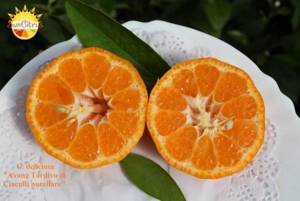
Late variety, ripening February-March. The pulp is juicy and aromatic.
Mandarin "Ciaculli piccolo" \ "Ciaculli"
C. reticulata "Ciaculli piccolo" \ Small Ciaculli mandarin
Ciaculli is a remote suburb of Palermo, Sicily, Italy, located near the suburb of Croceverde. Piccolo = small - small. Tangerines from Ciaculli\Ciaculli are sweet, very aromatic, thin-skinned tangerines, one of the most famous in Sicily. They are grown on just 200 hectares by small farmers. Tangerines from Ciaculli are included in the Slow Food list of unique products.
Hybrid mandarin "Temple X Dancy"
Temple X Dancy mandarin hybrid
The crown is compact, dense, not weeping in shape. Thorns are absent or extremely rare. The lionfish is narrow, the leaf shape is similar to a tangerine. The fruits are spherical, the skin is thin, slightly rough in texture, and orange when ripe. The taste is sweet and sour, seeds are present.
Tangerine \ Mandarin "Sugar Beauty"
Tangerine "Sugar Belle"
Sugar Belle Tangerine - LB8-9 US Patent PP21,356 - was granted to the University of Florida. Sugar Belle is a hybrid between Mineola (aka Honeybell tangelo) and Spanish Clementine. The fruit has a pronounced, pleasant aroma, the taste is sweeter than Minneola, but with a large amount of acid when unripe. Sugar Belle also contains 40% more vitamin C than Mineola and ripens 4-6 weeks earlier than Mineola! This is an excellent citrus variety for colder regions. The fruit is bright orange, bell-shaped, and easily peeled. Ripens in November-January. Self-pollinating. Zones 8B-10.
Triploid hybrid "Mandalate"
Ibrido Mandalate®
Triploid hybrid obtained by crossing Mandarin "Fortune" (2x) x Mandarin "Avana" (4x), made and patented by researchers from CRA-ISAGRU Acireale (Catania). Researchers: Giuseppe Reforgiato Recupero, Giuseppe Russo and Santo Recupero. Medium height, has small thorns. Elliptical leaves with a pointed apex, medium-length petiole with rudimentary ribs, similar to those of a tangerine. The fruits are flattened, average weight about 100 g, thin skin, fine-grained orange surface with a small ring base at the bottom of the fruit. Ripening later, the crop begins to ripen in late February and continues until April. The fruits stick well to the tree. This hybrid has an interesting feature - the sterility of the pollen, therefore, does not cause the formation of seeds in the fruits of other citrus varieties, and is also seedless. Blooms very early. The taste is similar to the "Avana" mandarin and, when ripe, is close to the "Tardivo di Ciaculli" mandarin.
Tangerine \ mandarin "Sunburst"
Tangerine "Sunburst"
A complex hybrid of Robinson tangelo and Osceola tangelo, both of which are in turn hybrids of Clementine mandarin and Orlando tangelo. It was introduced as a USDA variety in 1979. in Florida, USA. This is a brightly colored, aromatic, juicy and thin-skinned variety and, as it turns out, very early. Disadvantage: difficult to clean and has a lot of seeds when cross-pollinated. In the absence of pollination, citrus fruits do not produce seeds.
Mandarin "Keraji"
C. "Keraji"\mandarino "Keraji"
The fruits are small to medium-sized, flattened at the poles, with a groove at the bottom. Unlike other tangerines, the peel is yellow. Thin, easily separated from the pulp. The pulp is amber-yellow, sweet, juicy, with a honey flavor. The variety is early ripening and productive.
Mandarin "Cleopatra"
C. reshni\mandarino Cleopatra
Mandarin "Cleopatra" comes from India. The tree is compact, with a rounded crown, without thorns. The leaves are small and narrow. The flowers are white, small. It looks very decorative all year round, due to its beautiful lush crown, remontant flowering and fruiting. The fruits are small, spherical, strongly flattened above and below, similar in appearance to clementine fruits. The peel is thin and easily separated from the pulp. When unripe, the peel is orange-green in color and the flesh is sour in taste; it is better to wait until it is fully ripe. When fully ripe, the peel is orange-red. The texture of the pulp is soft and juicy, the taste is sweet and sour, closer to sweet. The variety is remontant and grows and bears fruit well indoors.
Triploid "Clara"
Ibrido triploide "Clara"
A triploid hybrid obtained in 1980 by crossing the Montreal clementine and the Tarocco tetraploide orange. The tree is not very vigorous and occasionally has thorns. The fruits are large, usually obovate, slightly flattened, and turn bright orange when ripe. The pulp is slightly pigmented and very juicy, there are no seeds. The taste is reminiscent of Tarocco, but sweeter. The main wave of flowering is in spring, fruit ripening from mid-January to late February.
Triploid "Camel"
Ibrido triploide "Camel"
Triploid hybrid of clementine "Nules" and tetraploid mandarin "Avana", obtained in the 1990s, in Acireale, from a study begun in 1978. The tree is similar to the Avana mandarin, but has thorns and a more vigorous growth rate. The fruit is medium-sized, pale orange, easy to peel. Usually ripens from December to January. The flavor is a mixture of Avana mandarin and clementine.
Mandarin "Fremont"
C. deliciosa “Freemont”
Mandarin "Michal"
C. reticulata "Michal"
The Michal mandarin is considered a natural hybrid of the Commune clementine and the Dancy tangerine. Ripens from October to December (November to January). The variety is early ripening, the fruits are of good quality, easy to clean. Fruits are medium to small in size, variable number of seeds. A distinctive feature of the variety is the clear dependence of the size of the fruits on their number on the tree. The bright orange fruits are very decorative. The pulp of the fruit also has a bright orange color and a distinct aroma. The pulp is very tasty and aromatic (juice up to 44%), a little acid and several seeds (6 on average).
Mandarin "Carvalhaise"
C. deliciosa “Carvalhal”
An early variety of hybrid origin, one of the parents is called Mediterranean mandarin (C.deliciosa). Cultivated in Portugal and sometimes exported to European countries. A straight, upright growing tree with long, pointed leaves. The fruits are medium or large, usually spherical or oval in shape and have a thick, strong, well-fitting orange peel (in ripe fruits). The pulp of the fruit is very juicy, slightly sour and contains many polyembryonic seeds. The ripe fruit can hang on the tree for a very long time without any significant loss of quality.
Mandarin "Palazzelli"
C. deliciosa "Palazzelli"
A plant with a dense crown, very vigorous, with small thorns. The leaves are similar to clementines, the flowers are medium-small. The fruit is oval-shaped, with a roughly wrinkled surface, average weight 110-120 g, size from medium to large. The peel is of medium thickness, the partitions are thin and tender, on average consists of 10 segments, the pulp is juicy, with a large number of seeds. Very prolific, with alternating fruiting. The variety is late, ripens from February to June.
Mandarin "Pectinata"
C. deliciosa "Pectinata"
Pavlovsky Mandarin
(Pomeranian)
Known under the names Pavlovsky mandarin \ Pavlovsky orange. This name is most likely due to the simultaneous similarity of orange fruits with the fruits of orange and mandarin. In fact, Pavlovsk orange belongs to oranges, or bitter oranges. Leaves without lionfish are similar to tangerine ones. Flowering and fruiting are abundant and remontant. The petals are slightly tinted purple. The fruits are bright orange in color, there are a lot of fruits and in appearance/size they are more similar to tangerine fruits. The peel is easily separated from the pulp. The pulp tastes fresh and juicy. A bitter taste may be present if there was little sunlight during the ripening process. Thus, summer-ripened fruits have a sweetish taste, without bitterness.
Citrus austere
This group of varieties is of Chinese origin. Their distinctive feature is the rich orange-red color of the peel and pulp, as well as a delicious sweet taste due to the high sugar content (on average 13%). The most colorful variety of Austere tangerines is the tangerine. Despite the fact that this fruit is often considered as a separate type of citrus fruit, in terms of varietal characteristics it is still more similar to a tangerine - the same, albeit less pronounced aroma, easily separated segments and peel, and tender pulp.
Tangerine trees are low, with a compact, dense crown consisting of narrow leaves. Their fruiting is more extended and lasts several months starting in October. Tangerine fruits are larger in size than mandarins. They can be of different shapes: flat-round or pear-shaped. Their color can also be different: dark orange, yellow with green, or completely green. Tangerines are widely cultivated on an industrial scale in the USA; small plantations of these trees grow in Italy and Sicily.

When do tangerines ripen?
Despite the fact that market counters are filled with tangerines almost all year, this happens due to proper storage organization.
In general, the peak harvest time is December. In particular, the ripening season depends on the variety and geographical location of tangerine trees.
In Abkhazia, the tangerine harvest season begins in mid-November and ends in mid-December.
In Spain, thanks to a more favorable climate, fruiting continues from early November to late January.
Chinese varieties are ready for harvest in early September.
The harvest season in Turkey begins in mid-October.
Citrus deliciosa
A Chinese-Mediterranean group of varieties, including tropical species of tangerines. In terms of external characteristics, these varieties are in many ways similar to the previous group - their fruits are sweet, practically without seeds, and have a bright skin. Most tangerine trees from this group are ideal for home growing because they are small in size.
The most famous representative of the Deliciosa group is the Willow leaf mandarin. It is a small tree with a compact crown and dense dark green foliage. The fruits are quite large (6–7 cm in diameter), have a delicious sweet taste, and can be flattened or pear-shaped.
The variety Avana Apireno, a low-growing indoor tangerine with large, leathery leaves for a small tree, is often grown as a potted crop at home. The fruits of this variety are small (4.5–6 cm), spherical, with a small neck, bright orange peel and pinkish juicy pulp.
Tardivo di Ciaculli is an equally famous representative of the Deliciosa group, belonging to an Italian selection. The tree is small, graceful, the foliage is small and dense. The fruits are dark orange, very sweet and aromatic due to the high concentration of essential oils in the peel.
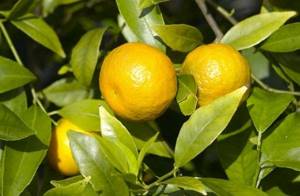
Types of tangerines and where they grow
The homeland of tangerine trees is Indochina. Having appreciated the undoubted advantages of fruits, our ancestors began to cultivate plants in other regions. Tangerine trees have begun their victorious march across the globe; the average lifespan of a tree is 70 years. Due to their hardiness, the fruit has taken root in areas where other citrus fruits cannot survive. On average, 600-800 fruits are collected from one tree.
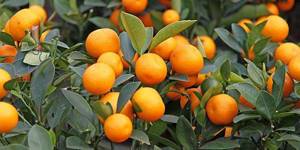
From China and India, sweet aromatic citrus fruits moved to Japan. Then they mastered the Mediterranean. They began to be grown in Italy, Spain, France, and Morocco.
The growing conditions of trees leave an imprint on the appearance of the fruits and their taste.
Tangerines are representatives of the Citrus genus. They belong to the Rutov family. This is a branched group of varieties and hydrides. The structure of the fruit is common with other representatives of citrus fruits: a dense peel protects the core, consisting of individual segments of pulp enclosed in a shell. They are distinguished by: rich sweet taste, ease of separating segments of pulp from each other, softness of the peel, easily separated from the pulp.
Otherwise, the variety of fruits is enormous:
- The color of the fruit varies from yellowish-green to almost red.
- Sizes range from 2 to 8 cm.
- The peel may or may not come off easily.
- The taste of the fruit is usually sweet or sweet and sour, but there are sour and tart varieties.
- The fruits also differ in the presence of seeds. They may not exist or may be present in large quantities.
These differences determine whether the mandarin belongs to a particular species. Let's look at some of the varieties:
- Unshiu is a type of tangerine tree adapted to temperate latitudes. Distributed in Georgia, Abkhazia, Crimea, and Krasnodar Territory. The weight of juicy fruits is approximately 70 g.
- Austere is a very sweet citrus. A characteristic feature is a rich orange color with a reddish tint.
- Tangerines are sunny orange fruits. The thick peel peels off easily and quickly. The soft juicy core has a sweet taste and a weak aroma. They bear fruit from mid-autumn to mid-spring.
- In addition to orange ones, another variety of tangerines has been developed - green tangerines, sweet and juicy. They bear fruit almost all year round.
- The sweet and sour variety of the Deliciosa species is cultivated in the Mediterranean and China. The shape is a flattened ball 6-7 cm in diameter.
- Citrus fruits of the Ponkan variety are distinguished by their original pear-shaped shape. The shell of medium thickness is easily peeled, revealing a juicy tender core, the taste is sweet and sour.
- The royal variety Nobilis stands out from the entire family due to its large size. The peel is thick with a lumpy structure. Juicy, aromatic, sweet pulp with a delicate aftertaste.
- The varieties Kishiu, Mukaku-kishiu and Shiva-mikan are suitable for growing fruits indoors. The fruits are small, but the plants grow well and bear fruit in a closed space.
- Of particular note is the Baby variety, bred in China. The fruits are so small that they are eaten in one go. Baby tangerines are loved for their honey sweetness and incomparable aroma.
Citrus reticulate
This group is conventionally called “Chinese-Indian”, since it is represented by varieties that are of industrial importance for these countries. In addition to India and China, Reticulata tangerines are grown on an industrial scale in Taiwan, the Philippines, and Brazil.
The most popular member of this group is the Ponkan, or Golden, mandarin, which is known in India as Suntara. Its fruits are large, round or elongated in shape with a small neck near the stalk. The peel is thick, easily peeled, and bright orange when fully ripe. The pulp is juicy and very tender, the seeds are small and few in number. In the Philippines, the main industrial variety is Batangas, the most superior tasting variety in this group.
Red tangerines
The peel is dark orange, almost red. The pulp is slightly lighter, tastes sweet, with a slight sourness.
Popular varieties of orange tangerines:
- Clementines. A variety of red tangerines with small, flattened fruits. The peel is rich orange, the flesh is juicy and sweet. They are the result of crossing with oranges. In many countries, the variety is a favorite of retail chains.
- Ellendale. The fruits of this fruit are large, with a loose skin of an orange-red hue, the pulp is tasty and aromatic, without seeds. They are the product of crossing orange, tangerine and tangerine trees.
- Tangors or tangelos (tangelos). They belong to the noble species, bright orange, with lumpy skin and flattened shape. Obtained as a result of crossing with pomelo under natural conditions. Sometimes this tangerine is called orange.
- Robinson. A product of American selection, it grows mainly in Florida. Delicious sweet fruits, smooth peel of a rich color, difficult to remove.
- The fruits are medium-sized, flattened. The skin is deep orange with a red tint and is easily removed. The pulp is juicy, with a rich, distinctive taste, and a moderate number of seeds.
- They have a delicate aroma and sweet and sour taste. The skin is thin and difficult to clean. The variety was obtained by crossing Robinson and Osceola citruses
- Temple or Royal Mandarin. The fruit is sweet, tastes like an orange, with seeds.
- Cleopatra. Comes from India. Now it is bred in the USA, Australia, Spain, and is widely used for breeding new hybrids and varieties. The fruits are small, with thin, orange-red skin, the seeds are large, and the taste is sweet.
Red types of tangerines have a good presentation, and therefore are very popular. Many varieties of the group are hybrids; they can belong to different pomological groups.
Citrus nobilis
Indo-Chinese-Malayan varietal group of “noble” or royal tangerines. Their distinctive external feature is their large size, thick, very lumpy, tight-fitting peel, and delicious sweet pulp. This group has not been well studied, but the high flavor characteristics of royal mandarins suggest that it is most likely a natural hybrid of orange with mandarin or tangor. The best varieties of this group are: King (Siamese King), Tsao-Tse, Kunembo.
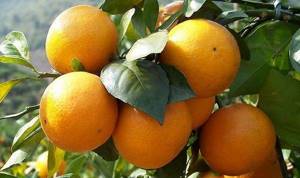
History of origin and homeland of mandarin
The genealogy of citrus fruits has been little studied, so information about the process of their cultivation is extremely scarce . To fill this gap, scientists from Spain, France and the United States have set out to trace the history of citrus crops. The research results were published in the oldest scientific journal Nature.
During the research, it was possible to find out that the first citrus fruits appeared in Southeast and South Asia . These fruits resembled all citrus fruits known today at the same time. Then the plant spread throughout the subtropics and tropics - from the western part of Pakistan to the central part of China, and appeared on the Polynesian islands, Melanesia, New Guinea and the northeast of the Australian continent. As a result of crossing plants with different traits, limes, lemons, oranges, grapefruits and tangerines appeared.

Led by Daniel Roxar (Joint Institute of Genetics of the US Department of Energy) and Manuel Talon (Institute of Agricultural Research of Valencia), a team of geneticists determined the sequence of nucleotides in the DNA molecule of 30 plant species from the genus Citrus . To do this, we used sequencing methods (translated from English as Sequence means “sequence”). At the same time, scientists analyzed the known genomes of 28 species of the genus Citrus and plants of the genus Severinia (Rutaceae). This helped establish the time and place of origin of citrus fruits.
Genetic evidence shows that the plants originated approximately 8 million years ago in southeastern China, northeastern India and Myanmar. This is confirmed by archaeological finds in Yunnan province - the fossilized remains of extinct citrus trees from the end of the Miocene (8-6 million BC).
The period of plant spread throughout tropical Asia took about 2 million years . According to scientists, this was facilitated by changes in climate - it became drier, and there were fewer monsoon rains.
In the process of "domestication" varieties and hybrids appeared . Citron became the “progenitor” for lime, lemon and tangerine. As a result of crossing pomelo with tangerine, oranges and larger subspecies of tangerines emerged. And grapefruit appeared thanks to the cross-pollination of orange and pomelo.
Mandarin has its own hybrid forms:
- Tangelo (photo below) is the result of crossing a tangerine and a grapefruit. The taste of the fruit is reminiscent of oranges.
- Tangors are the result of crossing a mandarin and an orange. The taste is tangerine, with sourness.
- Mandarin Satsuma or Satsuma is a sweet mandarin with juicy seedless pulp.
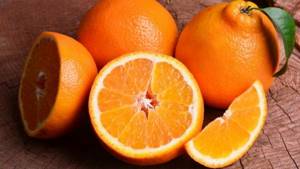
Citrus fruits appeared on the territory of modern European countries, including the Mediterranean, approximately 2.5 thousand years ago . In Syria, Egypt and Palestine, citron was highly valued, despite its inedibility. Tangerines were brought to Europe at the beginning of the 19th century. According to one version, in 1840, Neapolitan Michel Tenor brought a tangerine tree to Italy. Europeans liked the fragrant fruits. At first, the crop was grown in greenhouses, then in open ground in the south of Italy and France, and later in other countries with mild climates.
Interesting things on the site:
Health benefits and harms of tangerines
What is pomegranate, is it a citrus or not?
First mentions and origin of the name
A Chinese manuscript dated 1178 describes 27 varieties of tangerines . The fruits of the tangerine tree received their usual name in China. According to one version, tangerines were available exclusively to rich and well-born Chinese officials - mandarins. Translated from Portuguese, mandarim means advisor. According to another version, the fruit received its name due to the similarity of the color of the peel and the color of the clothes of officials.
It is most correct to call exclusively yellow fruits tangerines . Orange-skinned fruits are commonly called tangerines in other countries. However, in Russia this color division did not take root.
Interesting. The Chinese have a New Year tradition that dates back to more than 1000 BC. e. - give the owners two tangerines upon arrival. The owners of the house give the same amount of fruit to departing guests. Translated from Chinese, “a pair of tangerines” means “gold,” which is quite symbolic.
Is this a fruit or a berry?
According to the botanical description, tangerine is a representative of citrus fruits, that is, neither a berry nor a fruit . The scientific name of the mandarin is hesperidium, a multi-seeded, multi-locular fruit, a special variety of berry-shaped fruit. The pulp is covered with exocarp - a shell of rich yellow color. Underneath it is a spongy layer - albedo and endocarp. Hesperidium is formed from the superior ovary, which is typical for the citrus subfamily.
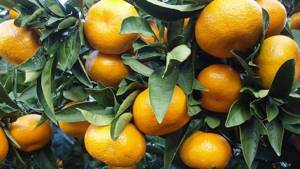
Chinese-Japanese group
This group includes small-fruited, low-growing varieties that are so often grown at home. The Chinese-Japanese group is very diverse. It is represented by various species and varieties, originating in both China and Japan. These tangerines also differ in taste: they can be sour (Shiva-Mikan) or very sweet (Kishiu).
Shiva-Mikan, although slightly sour, is a very decorative indoor variety. The tree is undersized, but due to the large leaves its crown seems massive. It belongs to the early varieties, blooms profusely, and already in mid-autumn it can delight you with fragrant fruits.
Dwarf varieties of Japanese selection belonging to the Wase line are ideal for home keeping: Kovano-Wase, Miho-Wase, Okontsu-Wase and others. This indoor tangerine is only 40–50 cm high, but under natural conditions it can grow up to 1 m. The trees begin to bear fruit in the 2nd year of life, bloom profusely and delight with their fruits all year round.

Classification of tangerine varieties
There are many natural varieties of mandarin and artificially created hybrids. They differ not only in their distribution area, but also in the method of cultivation and the color of the peel. Some types and varieties of citrus fruits are sold seedless, while others have a mild, sweet flavor.
Scientific
Varieties of tangerines, photos and descriptions of which can be found below in the list, are divided into the following groups:
- Unshiu (Citrus unshiu). Another name is satsuma. This is a dwarf plant that grows well in temperate and warm climates. It was first discovered in Japan. With its help, seedless hybrids and sweet varieties were bred. Industrial-scale tree plantations can be found in Abkhazia, Crimea and Georgia. The average fruit weight reaches 70 g. Frost-resistant varieties tolerate temperatures down to -10°C. Citrus fruits have a rich orange color. There may be green spots on the peel. They have thin skin.
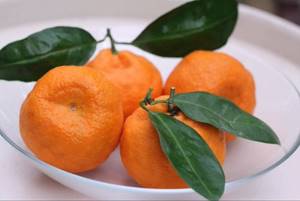
- Citrus austere. This is the sweetest variety of citrus fruit. Fruits from China with a rich orange peel have juicy pulp. In the EU countries it is called differently: Sicilian citrus. Widespread in the USA.
- Hybrid varieties. These fruits took all the positive characteristics from the parent species of tangerines or other citrus fruits, which were crossed to create a new species. They have different sizes, tastes, smells and weights.
- Tangerines. Heat-loving fruits grow in Italy. Trees with small foliage produce medium-sized oval tangerines. When the yellow, thin-skinned fruit is broken, the air is filled with a distinct aroma.
- Citrus nobilis. Grown in southeast Asia. Large fruits with a rough surface and thick skin.
- Japanese-Chinese variety. Representatives of these species are often cultivated at home. Dwarf trees are easy to care for, so they grow well in apartment conditions.
- Citrus deliciosa. Like previous varieties, this one can be grown independently on a windowsill. But trees can grow up to 1 m in length, so it is recommended to immediately transplant them into large pots. The leaves are saturated with essential oils, so a pronounced tangerine aroma spreads throughout the apartment.
- Citrus reticulata. Another name for Indo-Chinese. It is grown on a large scale in the Philippines.
We recommend that you read The Country of Homeland of Tangerines
By color
Based on the color of the peel, the following types are distinguished:
- green;
- red;
- yellow.
In Russia and the CIS countries, yellow and red varieties predominate. Greens are considered unripe and, due to their sour taste, are not very popular in the consumer market. You can often find hybrid orange, bright yellow and green-yellow fruits in markets.
Mandarin hybrids
What citrus fruit has not been crossed with the tangerine? As a result of these numerous experiments, a whole group of tangerine hybrids was born, distinguished by a variety of shapes, colors and tastes:
Tangor. This is a separate group of varieties that combine the taste characteristics of tangerines and sweet orange. In appearance and size, the fruit is more similar to an orange, but from tangerines it has an easily peelable, bright orange or reddish peel. Tangor pulp is juicy and sweet, with a rich citrus aroma.

Calamondin is a hybrid of kumquat and tangerine. The fruits of this tree are quite small (2.5–4 cm), have a thin, aromatic orange peel, but taste sour and contain many seeds. For this reason, the hybrid is often grown as an indoor crop. Indoor calamondin is a very decorative evergreen tangerine tree with large white flowers during flowering, and bright fruits that ripen all year round.
The fruit obtained from crossing tangerines and lemons (limes) is called Rangpur. This hybrid is widespread in India, but due to its unpretentiousness and high yield, it has recently begun to be cultivated in many tropical countries. Rangpur is similar in appearance to a tangerine, but is as sour as lemon, so it is used in cooking mainly as a seasoning. The fruit is usually bright orange in color, but there is also a variety with dark red flesh and skin.
Clementines. This is a type of hybrid tangerines that make up a whole separate group of varieties. They appeared as a result of crossing a tangerine with a bitter orange (orange), but we can safely say that the taste of clementine is no worse than tangerines - the fruits are just as sweet and juicy, and their glossy thin peel is easily separated from the pulp. Among clementines, there are varieties with seeds (Spanish, Montreal, Algerian) and without them (Corsican).
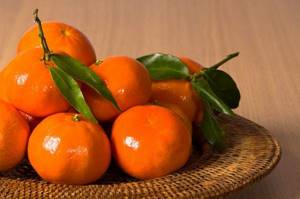
In addition to the well-known hybrids listed above, there are a couple dozen more exotic fruits, in the selection of which mandarin also participated: Mineola (tangerine with grapefruit), Ellendale, Agli (a mixture of mandarin, tangerine and orange), Tangelo (mandarin with pomelo) and many interesting varieties of citrus fruits.
Green and yellow tangerines
Based on green and yellow citrus fruits, new varieties have been developed, which are named after the country of origin:
- Abkhazian. Small fruits with seeds have a sweet and sour taste. The yellow peel with green dots is easily removed and has a pronounced aroma due to the high content of essential oils.
- Turkish. Small tangerines are difficult to peel due to the fact that the peel dries quickly and adheres tightly to the film of pulp. They have a light orange tint. There can be up to 3 seeds in 1 slice. Characterized by a fresh, sour taste.
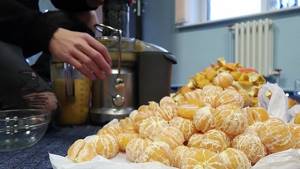
- Georgian. Brought out from the Abkhazian, but have a sweeter taste and large size. They are preferred to be grown in Adjara.
- Chinese. Yellow tangerines with sour and juicy pulp. You can find at least 1 seed in a slice.
- From Serbia. The small fruits are covered with a thick crust, which is easily separated from the pulp. The only drawback is that they are too sour, so they are not bought by everyone.
- Afurer and Nadorcott. Similar varieties have yellowish-orange flesh and skin with a similar shade. Fruit trees reach a height of 2-2.5 m and produce their first harvest 18 months after planting. Grown in South Africa. Afurer ripens in January and is not afraid of frost. There are no seeds in its pulp.
- Filipino. They are distinguished by an unusual rich green tint and a rough surface. When opened, orange flesh is visible. The slices are juicy.
- Moroccan. The golden peel is easily peeled off from the sweet segments. They have no seeds.
- Israeli. They are of average size. Not every slice has seeds. The peel does not separate well.
We recommend that you read Everything about choosing figs
Of the green and yellow species, the Murcott variety tangerines, as well as the Honey hybrid, stand out. They are recognized as the sweetest. Some gardeners put the Dancy variety, which has a mild, sugary-sweet taste, in third place. Its juicy pulp replenishes 30% of the daily requirement of ascorbic acid, but this species is practically not grown. This is due to the trees’ weak immunity to various diseases and high vulnerability to pests.
